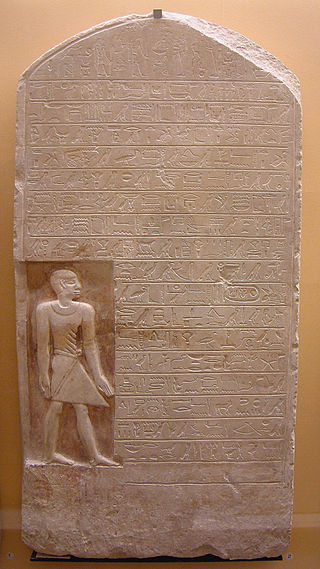
The Middle Kingdom of Egypt is the period in the history of ancient Egypt following a period of political division known as the First Intermediate Period. The Middle Kingdom lasted from approximately 2040 to 1782 BC, stretching from the reunification of Egypt under the reign of Mentuhotep II in the Eleventh Dynasty to the end of the Twelfth Dynasty. The kings of the Eleventh Dynasty ruled from Thebes and the kings of the Twelfth Dynasty ruled from el-Lisht.

Userkare Khendjer was a minor king of the early Thirteenth Dynasty of Egypt during the Middle Kingdom. Khendjer possibly reigned for four to five years, archaeological attestations show that he was on the throne for at least three or four years three months and five days. Khendjer had a small pyramid built for himself in Saqqara and it is therefore likely that his capital was in Memphis.
Intef III was the third pharaoh of the Eleventh Dynasty of Egypt during the late First Intermediate Period in the 21st century BC, at a time when Egypt was divided in two kingdoms. The son of his predecessor Intef II and father of his successor Mentuhotep II, Intef III reigned for 8 years over Upper Egypt and extended his domain North against the 10th Dynasty state, perhaps as far north as the 17th nome. He undertook some building activity on Elephantine. Intef III is buried in a large saff tomb at El-Tarif known as Saff el-Barqa.

The Thirteenth Dynasty of ancient Egypt was a series of rulers from approximately 1803 BC until approximately 1649 BC, i.e. for 154 years. It is often classified as the final dynasty of the Middle Kingdom, but some historians instead group it in the Second Intermediate Period.

Khasekhemre Neferhotep I was an Egyptian pharaoh of the mid Thirteenth Dynasty ruling in the second half of the 18th century BC during a time referred to as the late Middle Kingdom or early Second Intermediate Period, depending on the scholar. One of the best attested rulers of the 13th Dynasty, Neferhotep I reigned for 11 years.

Khaneferre Sobekhotep IV was one of the more powerful Egyptian kings of the 13th Dynasty, who reigned at least eight years. His brothers, Neferhotep I and Sihathor, were his predecessors on the throne, the latter having only ruled as coregent for a few months.

Merhotepre Sobekhotep was an Egyptian king of the late 13th Dynasty during the Second Intermediate Period.

Sekhemre Khutawy Amenemhat Sobekhotep was an Egyptian pharaoh of the early 13th Dynasty in the late Middle Kingdom.

Sekhemre Sewadjtawy Sobekhotep III was an Egyptian king of the mid Thirteenth Dynasty of Egypt who reigned three to four years.

Ankhu was an Egyptian vizier during the early 13th Dynasty in the late Middle Kingdom. He is believed to have resided in Thebes in Upper Egypt.
The Treasurer in Ancient Egypt is the modern translation of the title imi-r ḫtmt. The office is known since the end of the Old Kingdom, where people with this title appear sporadically in the organization of private estates.
Sobekhotep or Sebekhotep is an ancient Egyptian name meaning “Sobek is pleased” or “Sobek is satisfied”, and may refer to:

Senebhenaf was an ancient Egyptian vizier during the Second Intermediate Period.

Sekhemre Sementawy Djehuty was a minor king reigning over parts of Upper Egypt during the Second Intermediate Period.

Iah was a king's mother and queen of ancient Egypt c. 2060 BC, during the mid 11th Dynasty. Daughter of a pharaoh, possibly Intef II, and mother of pharaoh Mentuhotep II, she was the queen of Intef III.

Neferu II was the wife and sister of the ancient Egyptian king Mentuhotep II who ruled in the 11th Dynasty, around 2000 BC.
Neni was an ancient Egyptian queen of the Thirteenth Dynasty. She was the wife of king Sobekhotep III and the mother of two of his daughters: Iuhetibu Fendy and Dedetanqet. The only title attested for Neni is king's wife, the regular title of queens of this period. Not much else is known about her. There is a stela set up by her steward attesting that Neni had her own estates.

Mentuhotep was the non-royal father of the ancient Egyptian king Sobekhotep III, who ruled for about three years in the Thirteenth Dynasty, around 1750 BC.
Khakau was the brother of King Sobekhotep III of the Thirteenth Dynasty and part of a powerful family taking power in a time of political turmoil in Upper Egypt. Although not of royal birth, he was given the title of "king's son" by his brother.
Iuhetibu was an ancient Egyptian king's mother known from several sources as the mother of the 13th Dynasty king Sekhemre-sewadjtawy Sobekhotep, also known as Sobekhotep III, although recent research indicates that he was rather Sobekhotep II. Iuhetibu was the wife of the god's father Mentuhotep. She only appears in sources from the reign of her son. Nothing is known about her life before her son became king. She was the mother of several children. These are king Sobekhotep, the king's son Seneb, the king's son Khakau. Her granddaughter Iuhetibu Fendy, daughter of king Sekhemre-sewadjtawy Sobekhotep was most likely named after her.













